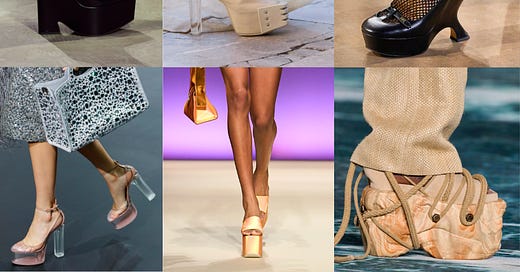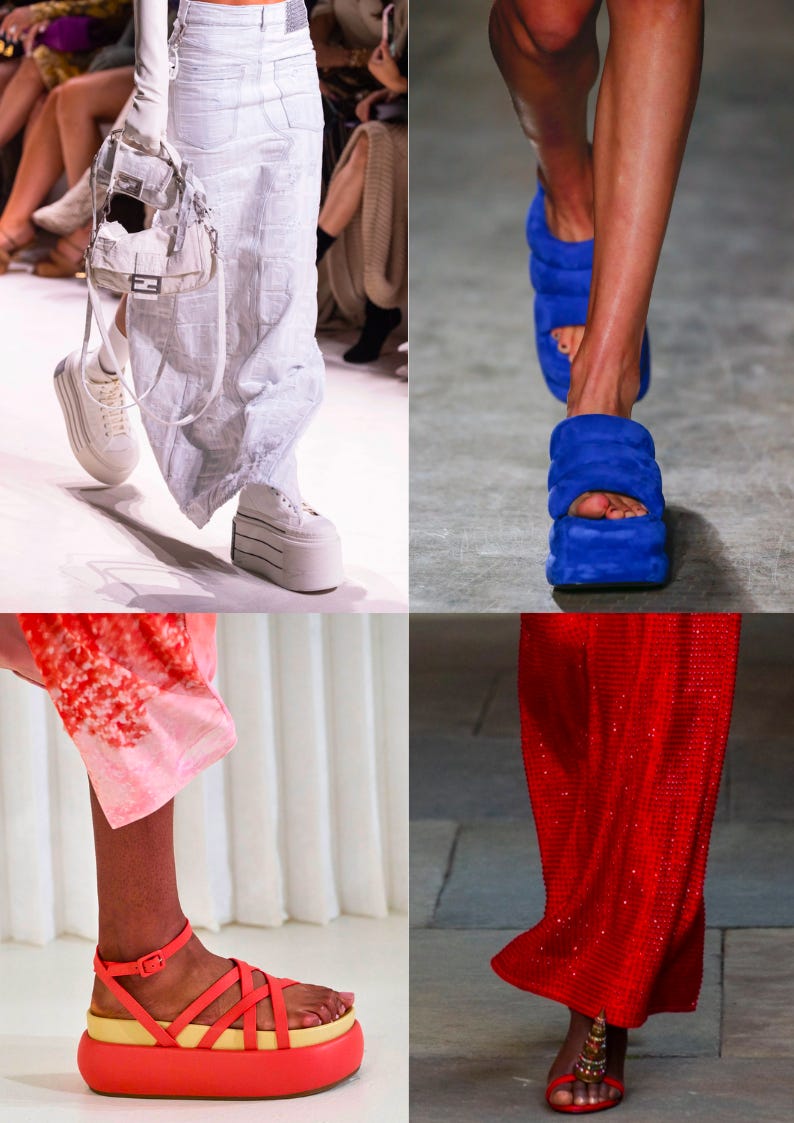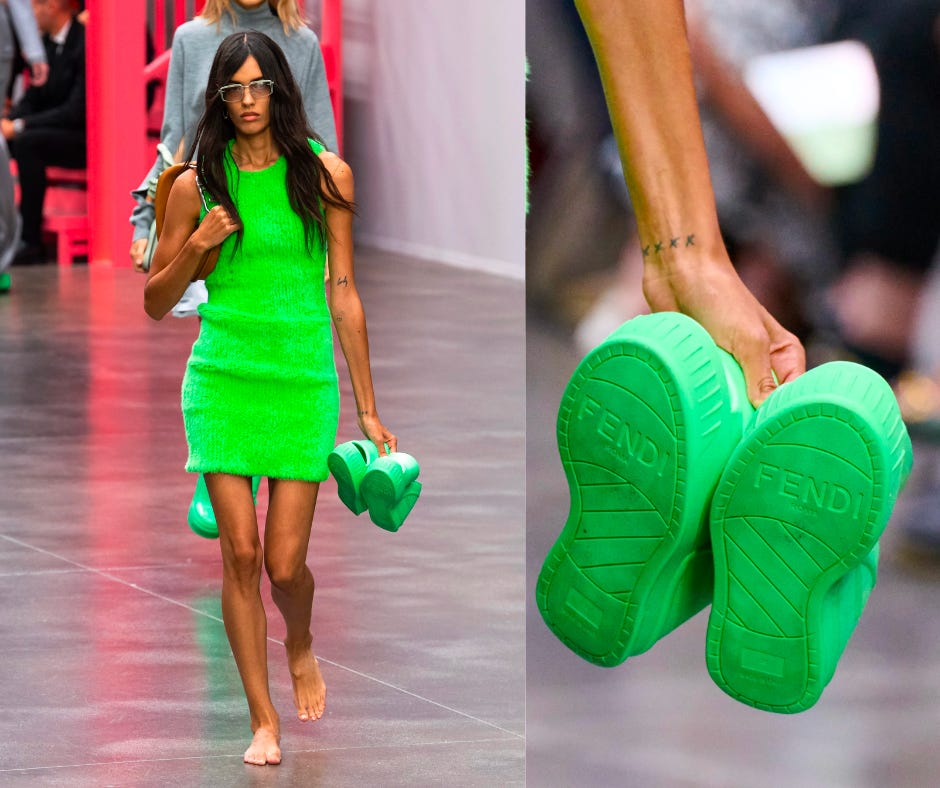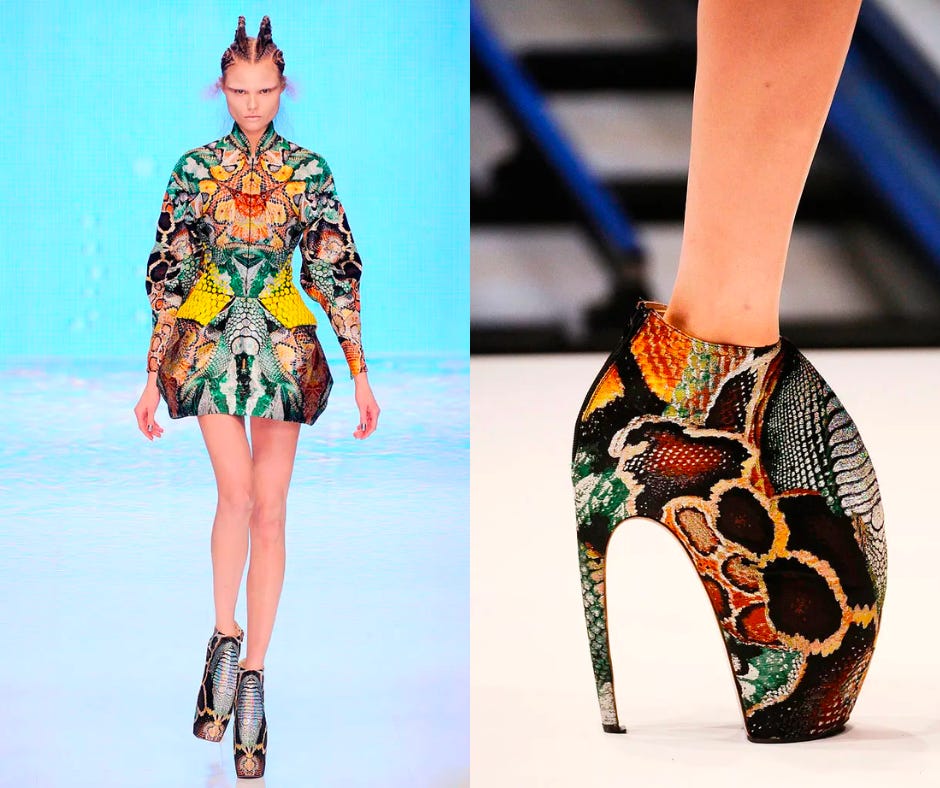

Discover more from Back Row
The Return of Dangerous Shoes
Strap on some platforms and say a prayer. Consider adding hiking polls for safety.
Thank you for subscribing to Back Row. This issue is free to read, but this newsletter is made possible by paying subscribers. If you’re on the free list, I hope you’ll consider upgrading your subscription for $5 a month — the price of a coffee in a city — or $50 annually. Paid subscribers receive two Back Row posts a week; they also enable me to keep this newsletter ad-free and accountable to readers instead of brands accustomed to buying lip service with marketing dollars.
You could feel it coming when Carrie Bradshaw breezed back onto our screens in And Just Like That, traversing Manhattan on foot in high heels. This show, as it was in 2002 — the era most influencing the runways today — was no place for comfortable shoes.
A birth defect instead of her decades-long unwavering commitment to high heels was the reason Carrie ended up needing hip surgery. Only then did her preferred heels become a dangerous commodity — something to be worn at her own peril.
This was foreshadowing for the rest of us: dangerous shoes were nigh.
They’ve been percolating for several seasons, now. Versace’s $1,575 Medusa Aevitas platform pumps burst onto the runways for fall 2021. Beyoncé wore them. Around the same time, Lady Gaga clomped onto a sidewalk wearing bike shorts, a sports bra, and 8-inch-tall $98 white Pleaser Shoes.
Thus the stage had been set for shoe drama when New York Fashion Week kicked off the spring 2023 season last month. Onto it strode towering flatform sneakers from Marc Jacobs’s portion of the Fendi Baguette spectacular; inflated-looking slip-ons at Proenza Schouler; still more inflated-looking flatforms at Jonathan Simkhai. (In fact, inflated-looking footwear was everywhere for spring 2023.) And then Area offered huge glittery spikes that protruded like unicorn horns from the toe. So if you had forgotten about statement shoes, hello… lover?
By the time we got to the Fendi show in Milan, things took a turn. A model in a fuzzy neon green knit mini dress appears in her Vogue Runway shot carrying her puffy platform slip-ons in her hand in a way that looks natural, like this is how it was supposed to be shown. But the reality was, TikTok revealed, she couldn’t walk in them.
Then came Valentino. The collection itself was overshadowed by models who appeared unsure of where to go on the runway, struggled to walk in their heels, and took painful-looking falls on a few stairs. Again, shoes were removed and carried.
Many critics pointed out how distracting this was. Cathy Horyn wrote in The Cut, “A number of the women either removed their shoes or soldiered on in visible pain.” Vanessa Friedman wrote in the New York Times about how designer Pierpalo Piccioli talked before the show about “his frustrations with fashion’s lip service to inclusivity” — yet found his message “undermined, somewhat, by… shoes so unwalkable that numerous models had to take them off.” Harper’s Bazaar’s Rachel Tashjian pointed out that the show notes trumpeted “personal choices” and “the depths of identity.” Yet:
…his models (almost all first-timers, though that isn’t an excuse) were struggling to walk in their stilettos and platforms. I saw a few models sweating at the turns of the runway and others with tears in their eyes, and witnessed two girls trip.
Vogue’s Mark Holgate reported that Piccioli said that the cast of unknown models was “for the audience to focus on who they are as individuals and not on their status in the industry. (Which might have explained why a few found the heels tricky.)”
Little strikes me as more humiliating or upsetting for a runway model than starting one’s career in a Valentino show, getting assigned a pair of difficult shoes, and then becoming known as the girl who fell, cried, or just couldn’t walk. No wonder they were visibly emotional. (While Piccioli was presumably well-intentioned in his casting decision, it’s worth noting that one of the most troubling trends in fashion in the aughts was models that were meant to be anonymous instead of stars like their nineties predecessors. This is in part what led to many girls under the age of 18 flooding the runways and getting taken advantage of by the industry.)
Something went horribly wrong at Valentino, as evidenced by the numerous labels — Versace, GCDS, Rick Owens, and Bottega Veneta — that produced super-high heels that models managed to walk in just fine. Business of Fashion noted Balmain’s “heavy references” to Alexander McQueen’s spring 2010 Plato’s Atlantis, particularly the enormous platform shoes, some of which appeared tied onto the models' feet with rope, like a boat to dock. Even Maria Grazia Chiuri’s Christian Dior, which many internet fashion fans have seemed to loathe on the basis of its wearability alone, showed thick platform pumps with a rounded toe and dramatically recessed heel (a recessed heel is supposed to be more comfortable than a heel that falls in line with the back of the shoe, since the wearer’s weight falls closer to their center of gravity). They don’t exactly look comfortable, but might be considerably more so than the sorts of standard issue non-platform stilettos shown at the likes of Saint Laurent and Stella McCartney.
I remember writing about dangerous shoes for The Cut when I was starting my career as a fashion blogger. The trend of extreme heels was peaking, coming to spectacular climax with McQueen’s Plato’s Atlantis show, which included “armadillo” ankle booties measuring ten inches high. These had been preceded by shoe-related runway carnage at the spring 2009 Prada show, where thanks to faulty heels sometimes paired with slippery socks, two models fell and many more stumbled, leaving some to remove their shoes altogether. The Telegraph reported at the time:
“I was having a panic attack, my hands were shaking. The heels were so high,” one of the models said. “Some of the girls were crying backstage they were so scared.”
Of all the trends to resurrect from this century’s first decade, why this one? Sure, you could also ask this about the other trendy Y2K-inspired nonsense like cargo pants and scarf tops, but those are far less likely to cause physical injury.
The sneakers-with-everything trend has practically been exhausted on the runways, therefore designers will mine the opposite extreme in order to get us to buy something we don’t have in our closets. And hot new shoe styles are as necessary for luxury houses to mint as “It” bags since shoppers are more likely to buy those than ready-to-wear clothing.
However, there’s also plenty to be said for the flats forever mentality. Designers who bucked the scary-high shoe trend circa 2010 won headlines and praise. The late Alber Elbaz let models in his spring 2011 Lanvin show switch to flat sandals at the last minute since they were nervous about walking in metal heels on the long runway. Surely not wanting a repeat of the Prada debacle, he told WWD, “The whole idea of fashion is to make women fly and to make women beautiful, and to make women glamorous.” Elbaz was beloved for making clothes for, as WWD put it, “real women rather than fashion editors.” Natalie Portman wrote in Time in 2007, “He says things to me like, ‘Wear flats. You're short. It's much cooler not to pretend.’”
Valentino’s Piccioli had previously taken a similar approach. For his couture show in July, he let models choose between flats, kitten heels, and stilettos since he had chosen as his runway an outdoor staircase in Rome more than 100 steps long and wanted them to walk with confidence.
Fashion’s great post-pandemic air kiss with the world was always expected to include glitz and drama from head to toe. Many of us probably didn’t wear anything but sneakers during the pandemic, which means that dressing up, even in shoes that look downright scary to wear, feels exciting again.
But so does feeling truly confident in one’s clothes. A lot of us spent the pandemic half dressed in Zoom tops and secret pants we didn’t want anyone we work with to see. I am self-employed and work from home, and feel no shame in admitting that when I dress in something other than loungewear and fix my hair and put on a bit of makeup, I feel a certain confidence boost. Fashion is at its best when it not only offers excitement, but also makes us feel like the best version of ourselves. So sure, bring back the party shoes, put a fork in sneaker fatigue — a lot of us are here for that. (Sneakers weren’t absent from the spring runways, though they were often elevated on a thick platform.) Maybe the super-high statement shoe is fashion’s clever counterpoint to Zoom tops (you want to see my shoes now that I’m out in the world again? I’LL SHOW YOU SHOES). But I’ll still be cheering for designers who have the confidence to defer to wearability and flats in a sea of shoes that look like risks, and not just from a fashion perspective.
At Chanel, Virginie Viard’s flats and low chunky heels stood out for looking like something you could walk around in all day. And at Loewe, Jonathan Anderson’s clear ballet flats suggested wearing no shoes at all. Which is ultimately what Fendi and Valentino ended up selling us, anyway.
If you haven’t yet, subscribe to Back Row to support independent fashion and culture journalism.












That Valentino video is really troubling somehow. The models look like newborn foals and it feels really dehumanizing. But I do remember being thrilled by the McQueen shoes (although I was also thrilled by the Jeffrey Campbell platform booties that were so emblematic of the noughties, so this possibly has less to do with my having good taste than it does with my buying into any and all fashion trends. See also, the Isabel Marant wedge sneakers I bought – and eBayed due to feeling ridiculous in them – more than once…)
oh god not a revival of those blasted platform stilettos (peep-toe for maximum late 00s) and designers boasting about how models who did ballet training were the ones who had no trouble walking in their stilettos and 'women like to suffer for beauty'.
There's a reason ballet flats and Converse were so popular back then despite the 'worse for your feet than high heels' narrative people used to push.